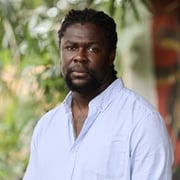Olivier Khouadiani’s Golikro is a place that both exists and doesn’t. The Ivorian photographer creates an imagined village alongside the real one of Amanikro, deliberately blurring boundaries to etch a new picture where traditions and modernization meet.
In the language of the Baoulé—one of the largest ethnicities in Côte d’Ivoire—‘Goli’ means mask, and ‘ikro’ means village. In Khouadiani’s Golikro, the mask represents ancestral traditions that have been lost, invoked back into the present by the children that feature in his staged photographs. “Traditionally, masks make a connection between the living and the dead, protect the village, and help people solve problems,” the photographer says.

Khouadiani uses several other creative means to reach across and commune between these realms. For one, creating the photographs in black and white was another way to connect to the spiritual and ancestral. “Black and white frees time. It is about all time. It reaches into the past, the present and the future.” The cast of characters that features in the images is also significant; a photograph of a spider is the first in the Golikro series. “Each animal represented by the Neo Goli has a role,” he says, “The spider builds a network, making connections with the ancestral worlds, with the living and the next generation to come.”

In the series, fantastical images of children playing gentle spiders or machete-wielding caterpillars blend with images documenting details of agriculture life in the village of Amanikro; lush closeups of real insects, a heap of decomposing cocoa pods. The rich and imaginative scenes taking place in the images, set against the backdrop of the village, are powerfully simple. Staged photography can often be burdened by many requirements; access to locations, models, props and special effects. Khouadiani works his magic with much less.

A photograph of children, stacked up on each other’s shoulders and shrouded in fabric, standing next to a solar panel hints at the new technologies that are entering the infrastructure of the village. The photographer is a witness to the changes and sees the complexities that they bring. The series was created with the children of the village, he says, because, “they are the real solution for the future of their village”

This real village of Amanikro where Khouadiani stages these scenes is an agricultural village that the photographer was introduced to through a visual storytelling program via NOOR in partnership with the Chocolonely Foundation. The people of Amanikro moved from their home region in the center of Côte d’Ivoire to the south-west in order to access economic opportunities and to grow better cocoa.
The move created a dislocation and loss of agricultural and spiritual traditions, Khouadiani says. “When people hear about immigration, they’re always thinking about immigration from Africa to go to Europe or the USA, but even within our country, we have a problem with migration because when you leave your home and go to another place with different language, a different ethnicity and culture, they have to accept that you want to live there.”

Khouadiani himself has experienced loss of traditions firsthand. “The problem is I don’t speak Baoulé, I only speak French and English. I have to talk about my culture, about African culture. To me it is really important to tell our story. I feel sad because Baoulé is part of my DNA. If I don’t have this, I have to find another way.” Plans for finalizing the project include a song recorded with a Baoulé singer, portraits of villagers and a video element.
When Khouadiani presented early photographs from the series to the villagers, they instantly understood the work as a spiritual conversation. One man asked him, “Are you going to bring the Goli?” giving Khouadiani the idea for the title of the series. “At first they didn’t understand my approach, but when they saw the beginning of the series, they were captivated.”
Olivier Khouadiani is a winner of the LensCulture Black & White Awards 2023. Follow this link to discover all 38 winners of these prestigious international photography awards.









